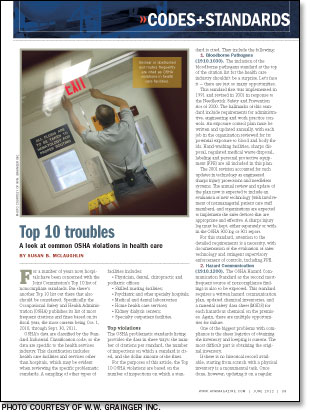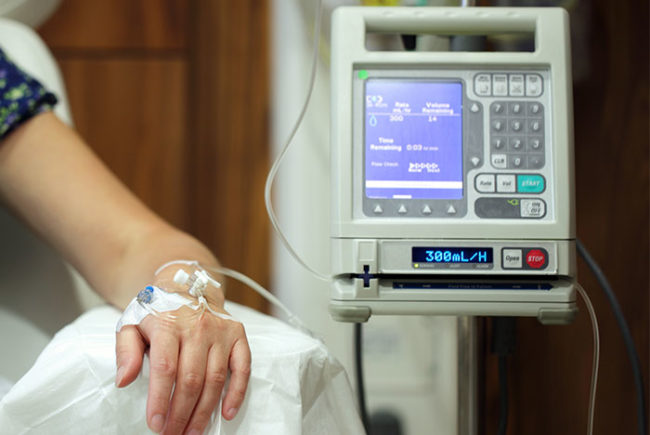 For a number of years now, hospitals have been concerned with the Joint Commission's Top 10 list of noncompliant standards. But there's another Top 10 list out there that also should be considered. Specifically, the Occupational Safety and Health Administration (OSHA) publishes its list of most frequent citations and fines based on its fiscal year, the most current being Oct. 1, 2010, through Sept. 30, 2011.
For a number of years now, hospitals have been concerned with the Joint Commission's Top 10 list of noncompliant standards. But there's another Top 10 list out there that also should be considered. Specifically, the Occupational Safety and Health Administration (OSHA) publishes its list of most frequent citations and fines based on its fiscal year, the most current being Oct. 1, 2010, through Sept. 30, 2011.
OSHA's data are classified by the Standard Industrial Classification code, so the data are specific to the health services industry. This classification includes health care facilities and services other than hospitals, which may be evident when reviewing the specific problematic standards.
A sampling of other types of facilities includes:
- Physician, dental, chiropractic and podiatric offices;
- Skilled nursing facilities;
- Psychiatric and other specialty hospitals;
- Medical and dental laboratories;
- Home health care services;
- Kidney dialysis centers;
- Specialty outpatient facilities.
Top violations
The OSHA problematic standards listing provides the data in three ways: the number of citations per standard, the number of inspections on which a standard is cited, and the dollar amount of the fines.
For the purposes of this article, the Top 10 OSHA violations are based on the number of inspections on which a standard is cited. They include the following:
1. Bloodborne Pathogens (1910.1030). The inclusion of the bloodborne pathogens standard at the top of the citation list for the health care industry shouldn't be a surprise. Let's face it — there are just so many opportunities.
This standard first was implemented in 1991 and revised in 2001 in response to the Needlestick Safety and Prevention Act of 2000. The hallmarks of this standard include requirements for administrative, engineering and work practice controls. An exposure control plan must be written and updated annually, with each job in the organization reviewed for its potential exposure to blood and body fluids. Hand-washing facilities, sharps disposal, regulated medical waste disposal, labeling and personal protective equipment (PPE) are all included in this plan.
The 2001 revision accounted for such updates in technology as engineered sharps injury protections and needleless systems. The annual review and update of the plan now is expected to include an evaluation of new technology (with involvement of nonmanagerial patient care staff members), and organizations are expected to implement the safer devices that are appropriate and effective. A sharps injury log must be kept, either separately or within the OSHA 300 log or 301 report.
For this standard, attention to the detailed requirements is a necessity, with documentation of the evaluation of safer technology and stringent supervisory enforcement of controls, including PPE.
2. Hazard Communication (1910.1200). The OSHA Hazard Communication Standard as the second most-frequent source of noncompliance findings is also to be expected. This standard requires a written hazard communication plan, updated chemical inventories, and a material safety data sheet (MSDS) for each hazardous chemical on the premises. Again, there are multiple opportunities for failure.
One of the biggest problems with compliance is the sheer logistics of obtaining the inventory and keeping it current. The most difficult part is obtaining the original inventory.
If there is no historical record available, starting from scratch with a physical inventory is a monumental task. Once done, however, updating it on a regular basis is much less daunting, provided there is a system and oversight.
Hospitals have approached inventory maintenance in many ways, from centralized to departmental systems. Unless there is some organizational oversight of a departmental system, it frequently results in a high degree of variability in the results. The OSHA standard does not define "current" for the inventory, but inventories without dates certainly will not be considered as current.
MSDS systems are also highly variable and fraught with problems. MSDSs may be available in any format. They must be available to employees in their work areas on their shifts. This does not preclude electronic systems, nor require that each employee have computer access.
Some hospitals still use paper systems. While this is acceptable, paper systems are difficult to maintain with the assurance that each MSDS is the most current and that an MSDS is actually available for each chemical in-house. There are multiple electronic systems available, ranging from CD to Internet-based to faxed.
When making a selection, health facilities professionals should consider whether a current MSDS actually will be available for each product in use in the organization. They also should consider back-up systems during power failures, which can be a battery-operated laptop, and doesn't have to be a paper copy.
Health facilities professionals should note that the Hazard Communication Standard has been newly revised (see the sidebar at right).
3. Forms (1904.29). This standard requires the use of the following three OSHA forms:
- OSHA 300: Log of work-related injuries and illnesses;
- OSHA 300A: Year-end summary of OSHA 300;
- OSHA 301: Incident report or equivalent form.
Each recordable injury or illness must be summarized in the OSHA 300 log with a 301 form describing the incident within seven calendar days of receiving the information. In some privacy concern cases, the employee's name may be omitted.
4. General Requirements (Electrical) (1910.303). This standard addresses the safety and suitability of electrical equipment for use within health care organizations. Equipment must be listed or labeled, used according to associated instructions and free of short circuits and nonpermitted grounds. Equipment must be secured firmly to the mounting surface and have appropriate air circulation as required. The manufacturer's identification and appropriate electrical ratings must be placed on the equipment. Clear working spaces and guarding of parts also is included.
5. Wiring Methods, Components & Equipment (1910.305). This standard details the requirements for electrical wiring and associated components, including raceways, cable trays and enclosures. Electrical transformers also are covered.
The following inclusions often are particularly troublesome in health care organizations: Temporary lighting may be used only during remodeling, maintenance or repair; holiday decorations may not be in place for longer than 90 days; flexible cords and cables, such as extension cords, may not be used as a substitute for fixed wiring and may not be run through walls, ceilings, floors, doors or windows; receptacles installed in wet locations must be suitable for that use, such as outlets with ground-fault protection; and electrical appliances must have appropriate nameplates.
6. Annual Summary (1904.32). This standard is related to the third-ranking standard (Forms) and provides more information about the required annual summary on form OSHA 300A.
It provides instructions for completing the annual summary based on the OSHA 300 log, and requires certification of the summary by an owner or officer of the corporation.
The annual summary must be posted in a conspicuous place where employees typically read announcements, and must be in place from Feb. 1 to April 30 of the year subsequent to data collection.
7. Medical Services & First Aid (1910.151). This brief standard requires the availability of medical personnel to consult on issues of occupational health and the availability of prompt treatment or first aid. Neither should be an issue for health care organizations.
But, here's the catch: Item (c) of this standard states, "Where the eyes or body of any person may be exposed to injurious corrosive materials, suitable facilities for quick drenching or flushing of the eyes and body shall be provided within the work area for immediate emergency use." This is the requirement for eyewash stations and drenching showers, a frequent source of hospital findings.
8. Maintenance, Safeguards, & Operational Features for Exit Routes (1910.37). Hospitals, required to be compliant with the National Fire Protection Association's NFPA 101, Life Safety Code, will be very familiar with the requirements of this standard, which include free and unobstructed exits; no exiting through hazardous areas; working features of fire protection, such as alarms, sprinklers and doors; lighting and marking of exit routes; and available exits during construction.
Despite the familiarity, many health care organizations are cited by the Joint Commission, Centers for Medicare & Medicaid Services and others for these issues and they struggle with compliance on a daily basis.
9. General Requirements (Personal Protective Equipment) (1910.132). This standard includes the general requirements for PPE and is followed by other standards that address specific types of PPE. This includes the requirement that PPE be made available by the employer to the employee as required by the nature of the job responsibilities and that PPE be maintained in sanitary and reliable condition.
Each workplace must be assessed for hazards that may necessitate the use of PPE, through a written certification of hazard assessment. This is used to select PPE for each task. Outcomes must be communicated to employees and suitable PPE must be provided to fit each employee. Training is required for each affected employee and PPE use must be enforced.
In health care organizations, a variety of PPE is used on a daily basis. The details of the certified assessment and the condition of the PPE are likely causes of OSHA citations.
10. General Recording Criteria (1904.7). This final standard in the Top 10 is closely related to the third-ranking standard (Forms). It supplies the criteria for entry of an occupational illness or injury onto the OSHA 300 log.
Any of the following constitute recording criteria: Death; days away from work; restricted work or job transfer; medical treatment beyond first aid; loss of consciousness; and significant injury or illness diagnosed by a physician or other licensed health care professional.
The remainder of this standard addresses classification of illness or injury into these criteria.
Delving into details
While nothing on this list of violations is extremely surprising, the key to avoiding them is in the details.
Only summary information is provided here, so health facility professionals are encouraged to view the OSHA standards themselves for complete requirements.
Because many of these violations are frequently cited by regulatory organizations in addition to OSHA, a thorough review of these issues should be conducted to determine other vulnerabilities as well.
Susan B. McLaughlin, FASHE, CHFM, CHSP, is managing director of MSL Healthcare Consulting Inc., Barrington, Ill., and a former associate director of standards interpretation at the Joint Commission. She can be reached at smclaughlin@mslhealthcare.com.
| Sidebar - Revision to HazCom |
| For many years, the Occupational Safety and Health Administration has been working on a revision of its Hazard Communication Standard (29 CFR 1910.1200) as part of a new "Globally Harmonized System" that will standardize the classification of chemicals worldwide and aid worker understanding of chemicals used in the workplace. Details of this were released recently and significant changes in the new standard include:
Key compliance dates applicable to health care organizations are as follows:
Full details on the revised standard may be found at www.osha.gov/dsg/hazcom/index.html. |





